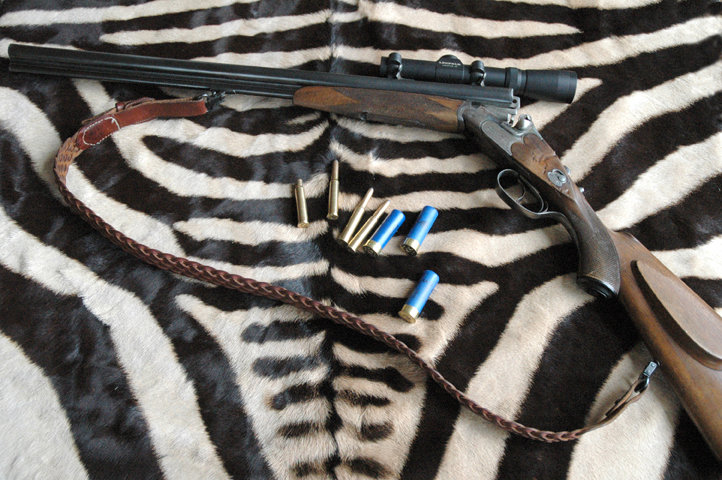
A DRILLING IN NAMIBIA
A different version of this essay appears in Magnum Magazine in South Africa
Three years ago on a plains game hunt in Namibia I had a great time, and killed some fine trophies; but not having thought to bring along a shotgun, I was unable to shoot any of the innumerable game birds that we saw on our stalks. In July of 2013, I did a dangerous game hunt in the far eastern end of the Caprivi Strip, followed by a few days in central Namibia. Knowing that I’d be back in prime game bird territory again, while preparing for the trip I decided to remedy my previous oversight.
I needed a "light rifle" for the hunt: while a .416 Remington is just the ticket for elephant, it's definitely “overkill” for adding lighter plains game to the bag. The solution was to bring along a drilling, the closest thing to an “all around gun” anyone has ever devised.

A very typical pre-WW 2 drilling: the box lock action has a Greener-type cross bolt and safety catch. The button on the top of the stock wrist selects rifle or shotgun barrels. Removing the narrow swivels left the bases in place, which can be used with quick-detachable swivels that accept a wider modern sling.
Planning such a trip starts well in advance: two years before leaving, I'd bought one through Cabela's "Gun Library" service, which offers many fine used guns. There I found a well-cared-for example made by H. Burgsmüller & Sohne of Kreiensen, in Lower Saxony. It bears Suhl proof marks and is dated June, 1940. It almost certainly came to the USA in the duffel bag of some returning soldier: as the men who fought World War II fade away, their much-prized war trophies are coming out of closets and back into use. It’s a very typical “Guild” product, the sort of item a prosperous merchant or landowner might own. Though it shows clear evidence of use, it locks up solidly and is as sound as the day it left Burgsmüller’s shop. Technically it's a "box lock" action in the Greener design: that is, it has a cross bolt that passes through the top rib extension, and a sliding safety button on the left side of the action. Most Americans are used to shotguns with a tang safety, but on this type of action the sliding button on the tang is a barrel selector. There's a bit of a learning curve in manipulating the controls, but it soons become second nature.
Good quality drillings—especially those marked by "name" makers such as Simpson or Merkel—can cost a lot of money, but in truth, the second-string ones are very, very good, and always very well made. A "Guild" gun from an unknown maker, or one by a less-well-known company (e.g., Burgsmüller) is usually very affordable. Furthermore, the actions on virtually all the nitro-proved drillings I've ever seen appear to have come from the same factory, and to have been fitted up by the makers to customers' requirements, regardless of whose name (if any) is stamped on them.
I’ve modified it a bit. Many drillings were originally equipped with removable scopes using claw-type mounts but I deliberately chose one that did not have them. Such mounts are unique to a gun/scope pair: once the pair is separated the bases are useless because custom-made replacement mounts can easily cost as much as the gun. I liked the idea of a removable scope, though, so I had my gunsmith install a set of Leupold quick-detach bases and rings. It now sports a Leupold 1.25-4X “Europlan” variable scope with a 30mm tube, which I can mount or dismount in seconds—and which always returns to zero.
The original horn butt plate was damaged; since I had to have the stock shortened to fit me I also had the smith install a sorbothane recoil pad. I don't like to shoot with a sling in place, regarding one of these as merely a convenient way to carry the gun; the small (3/4") non-detachable sling swivels typical of German guns had to go. This was simple: the screws that held the old swivels into their mounts were removed, and the resulting holes in the bases were a perfect fit for a set of quick-detachable swivels.
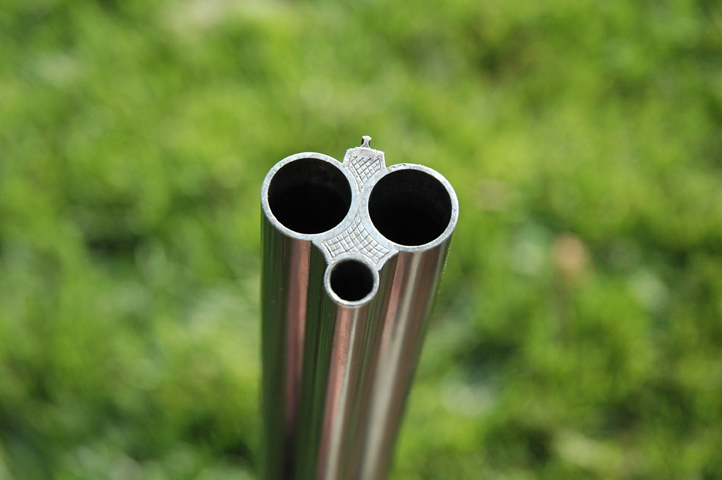
A side-by-side 16 gauge with an 8mm rifle barrel underneath is typical.
There are many other varieties of barrel combinations, but three in this setup
is by far the most common arrangement.
The shot barrels are 16 gauge, which isn't universal among Guild drillings, but very nearly so, because a 16 gauge represents a good compromise between weight, aesthetics, and performance. The chamber length was originally 2-1/2" but any 16 gauge ammunition is hard enough to find in the New River Valley. The 2-1/2" shells are scarcer than frog hair. I had the chambers deepened to take 2-3/4" ammunition.
Guns this old were of course designed in the days of paper shotshells and fiber wads, long before the invention of the plastic shot cup; they tend to be choked very tightly by today’s standards. I found it necessary to have the chokes opened up to Improved Cylinder and Modified.
The rifle barrel is chambered for the 8x57JR round (and, unusually, is specifically marked for it); therefore—as is the case with virtually all 8mm drillings of this vintage—it shoots a bullet of 0.318” diameter, not the more common 0.323" bullet used by most "8mm" rifles. The correct ammunition is still made by Sellier &Bellot, because the 0.318" bullet is still reasonably popular in Europe. Additionally, good bullets for reloading are available from several makers. The 0.318" has a slight ballistic edge over the 0.323" in that for the same weight it has a higher sectional density. I've had good success with reloads using Norma bullets in this diameter, but alas, Norma has discontinued this diameter; other makers' products (Woodleigh and Buffalo Arms) are available. Drillings tend to have fairly crude sights and to be regulated for one weight of bullet (typically stamped somewhere on the breech) and I've stuck to 196 grain projectiles, whether in factory loads or my own reloads. I have great affection for the 8x57 family of rifle calibers, with which I've taken several large animals—including a big eland bull. I wouldn’t hesitate to use this 8x57JR with bullets such as the Norma "Oryx," on the same species.
A word of caution is in order with respect to calibers in the rifle barrel. Many individual gunsmiths had their own proprietary cartridges, and all of them used their own gauges to measure bore size and so forth. Take any rifle caliber marking on a drilling with a grain of salt, and if in doubt have a chamber cast made to determine what, exactly, it shoots. Mine is unusual in that the exact caliber is indicated. Most drillings have a very vague indication, if any at all.
So a caliber marking on a drilling has to be regarded as a pretty marginal indicator of what it shoots in most cases. For example, there is an "8x57" round sometimes chambered in drillings that is not even remotely close to the "8x57JR," "8x57RS," or any other "8x57" caliber. Using the wrong ammunition can have disastrous results, and unless a gun is very, very plainly marked, it may not be possible to tell what it shoots without a chamber cast and some diligent research in case dimensions and power levels.
Drillings with outside hammers are typically older guns, and will (usually!) be chambered for the 9.3x72R, a long-discontinued round that's far less powerful than the "9.3x62 R" still available. Using the modern 9.3x62R ammunition in one of these is guaranteed to wreck it. Before buying a drilling do some homework, and also learn about the German proof marks for various periods. It may save you some grief. The German Gun Collectors' Association has a great deal of information available and is a good place to start.
The rifle barrel on my drilling is remarkably accurate, far more so than I had expected. With the S&B product it shoots well under 1.5 MOA, if allowed to cool between shots. I believe the over-lying shotgun barrels act as a heat sink and also to stiffen the thin-walled rifle barrel, accounting for its accuracy.
I had ample opportunity to use both the shotgun and rifle capabilities after returning to central Namibia from the Caprivi Strip. I specifically wanted to try some flying birds. I’d shot pheasant with it in the USA, but wanted a crack at sand grouse and guinea fowl. Accordingly, one morning we went to a place near a water hole when the grouse were flying: my PH had obtained shot shells. After dismounting the scope I happily burned through a box banging away at them. I did manage a guinea, but only one. All the birds went to the camp manager/chef, who served them to us at mealtimes.
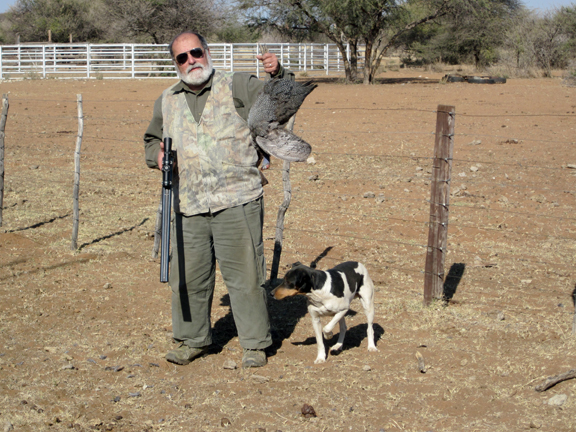
The lone guinea I managed to kill. The little dog at my feet is my PH’s hunting dog, Fox.
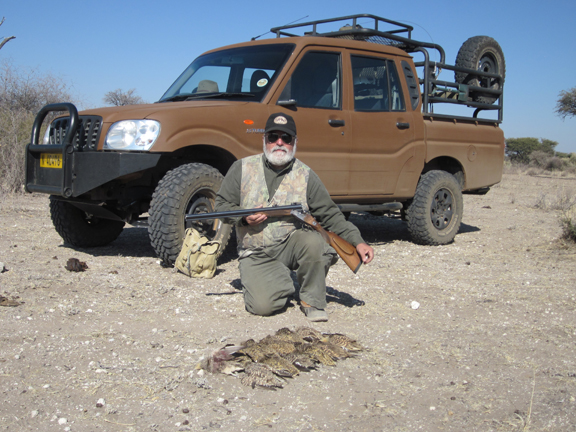
I did better on the grouse; these birds were downed at a water hole one early morning.
I’d hoped to take a hippo with my .416 but none were cooperative and I never got a shot. I decided that a big male ostrich would be a nice “consolation prize.” Though an ostrich is the largest bird in the world, a .416 is definitely overkill! I left it in camp and brought the drilling along instead.
Big Bird is sharp-eyed and very fleet of foot: five or six fruitless attempts to stalk an ostrich convinced me that an ambush from a high seat was the way to go. I accordingly spent two days trying that method. I did see one lone female, and let her pass. However, a number of obliging black-backed jackals came by to relieve some of the boredom: the rifle barrel dispatched them so rapidly that I suspect a few of them still don’t know they’re dead. The S&B ammunition has a round nosed bullet with a good bit of exposed lead, which makes an impressive exit wound in these small animals, dropping them in their tracks. I killed at least four in one evening, at ranges up to 200 meters, with the scope cranked up to 4x.
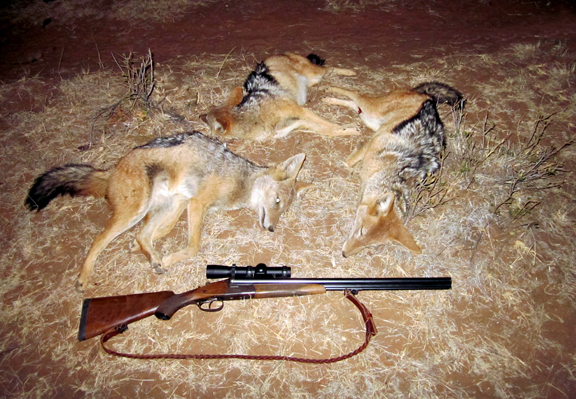
Three of the jackals shot from a hide while waiting for an ostrich.
The soft-nosed bullet S&B uses is exceptionally effective on animals this size.
On the last day, a brace of big male ostriches committed a major error of judgment. As we were entering a half-dried-up pan they came strutting past, entirely oblivious to our presence. I chose the larger of the two, and dropped him with one shot. His hide, now at the tannery, was supposed to become a purse for my lovely wife, who patiently puts up with my wandering off on long hunts now and then.
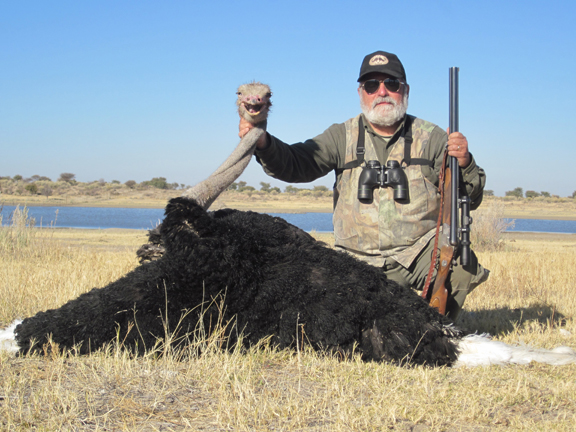
A big male who fell to a single shot from the rifle barrel.
Combination guns make a lot of practical sense. Restrictive laws in many countries that limit the number of firearms that may be owned, coupled with the variety of game that might be encountered in a single day, make one an eminently sensible proposition for a hunter. Drillings are especially popular in Germany for these reasons, but the fact is that a good drilling can handle almost any hunting situation. Combining a 16 gauge double with a reasonably powerful rifle makes it effective on small to medium-sized African game. Or, for that matter, American game: stand hunting for deer often brings opportunities for turkey or squirrels, and with a drilling across your lap, you are prepared for whatever comes by.
In June of 1940, the month my gun was made, the Wehrmacht had shattered the French Army and after rampaging through the Low Countries, was pushing British forces off the beaches at Dunkirk. Everyone involved in its manufacture is long since dead: even the firm of Burgsmüller & Sohne has disappeared as such. But their legacy of craftsmanship is evident in this “do-it-all” gun.
Addendum: I have since used the drilling on a deer cull; and on a Tennessee boar hunt in January 2015.
| HUNTING | GUNS | DOGS |
| FISHING & BOATING | TRIP REPORTS | MISCELLANEOUS ESSAYS |
| CONTRIBUTIONS FROM OTHER WRITERS|
| RECIPES |POLITICS |